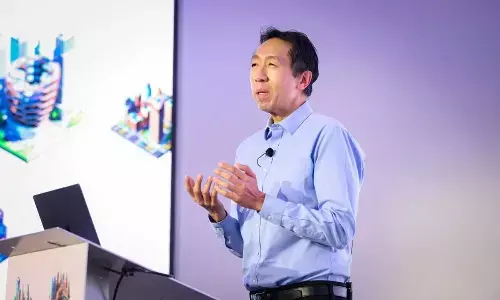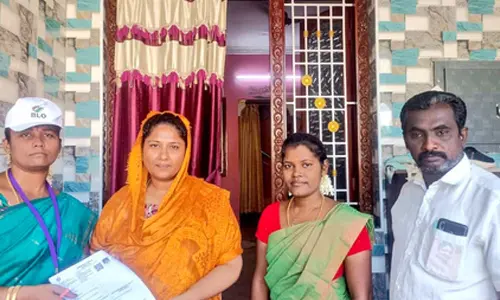Now, a Vision 2029 for AP

Andhra Pradesh always had a fascination for quantified targets. At times braving the political satire, the Government of Andhra Pradesh led by N Chandrababu Naidu was known for chalking out a vision for the state.
.jpg) Realisation of Vision 2029 requires a well-coordinated, multi-tracked development strategy. The existing institutional architecture is not fully equipped to deal with strategies required for an exponential leap in growth rates.
Realisation of Vision 2029 requires a well-coordinated, multi-tracked development strategy. The existing institutional architecture is not fully equipped to deal with strategies required for an exponential leap in growth rates.
Andhra Pradesh has set for itself a target of becoming one of the top three states in India by 2022 in terms of socio-economic developments and ease of doing business.
But, surprisingly, the World Bank in the recently released report on ‘Ease of Doing Business’ already ranked it second only next to Gujarat. Did the Government of Andhra Pradesh lack the vision in achieving the target so early, seven years ahead of the target? Has the World Bank overrated the new state?
An explanation is solicited. Achieving a sustained double digit growth demands a complete shift away from a business as usual approach. Effective monitoring and evaluation should be in place to transform the outlays into outcomes
Andhra Pradesh always had a fascination for quantified targets. At times braving the political satire, the Government of Andhra Pradesh led by N Chandrababu Naidu was known for chalking out a vision for the state.
Now as the Chief Minister of post bifurcation Andhra Pradesh, the Naidu government has come out with a Vision 2029. However, this Vision 2029 has failed to catch the imagination of the people and the opposition as in the case of Vision 2020 of united Andhra Pradesh. Perhaps, the political spectacle may unveil as the vision rolls out.
The Vision 2029 aims at transforming the state into a developed state. The vision document provides for rather formidable targets.
They include making the state a leading investment destination in the world by 2050. Double digit growth, better infrastructure, improved happiness index etc constitute the key milestones of this vision.
The Government of Andhra Pradesh in its rolling plan for 2015 entitled ‘Achieving Double Digit Inclusive Growth’ has set for itself a target of becoming one of the top three states in India by 2022 in terms of socio-economic developments and ease of doing business.
But, surprisingly , the World Bank in the recently released report on ‘Ease of Doing Business’ already ranked Andhra Pradesh second only next to Gujarat. Did the Government of Andhra Pradesh lack the vision in achieving the target so early, seven years ahead of the target? Has the World Bank overrated the new state? An explanation is solicited.
As the government itself acknowledges, to achieve the level of development envisioned in Vision 2029, the state will have to move from the current growth rate of 7 per cent GSDP to a double digit growth rate of more than 10 per cent for each upcoming year, beginning from 2015-16 (constant prices).
To Be more specific, the Gross State Domestic Product (GSDP) has to increase from a current level of Rs 5.2 lakh crore (2014) to approximately Rs 41.53 lakh crore by 2029.
Given the levels of growth performance in the past, this is certainly an uphill task . The state has to move heaven and earth to realise this vision. The critics may call it audacity, while the supporters may describe it as grand vision.
The experience has to tell. Meanwhile, the government vision document admits that while the state of Andhra Pradesh has displayed remarkable economic performance and succeeded in reducing absolute poverty , inclusive and equitable growth has not been commensurate.
The gains in many indicators under the Millennium Development Goals (MDGs ) are smaller in comparison with those in other southern states like Kerala and Tamil Nadu.
Growth is just a means but not an end in itself. Economic growth does not automatically translate into social or human development that defines the well-being of the people in a more meaningful manner.
However, higher levels of economic growth are essential to sustain the higher levels of social development . Andhra Pradesh should, therefore, combine the objectives of double digit economic growth with achieving more equitable and inclusive and sustainable economic growth to realise its Vision for 2029.
An appraisal of sectoral growth composition indicates that agriculture and industry have to grow much faster to accomplish the vision especially to make it inclusive by generating adequate employment.
The sectoral growth rates for 2014-15 (at current prices) for Andhra Pradesh are 11 per cent for agriculture and allied sectors , 9 per cent for industry and 14 per cent for services sector.
A wide variance exists in terms of the respective contribution of these sectors to the state GSDP. While the shares of agriculture and allied sectors and industry in the state GSDP have shown a declining trend, the share of services sector has witnessed a surge.
The agriculture and allied and industry sectors shares are currently 27.6 per cent and 20.6 per cent respectively and have declined from 28 per cent and 22.5 per cent respectively in 2005-2006. These sectors should, therefore, serve as growth engines.
The inclusive growth demands linking agriculture with valued added activities like agri business to make this sector viable, clustering micro, small and medium enterprises (MSMEs) for infusion of technology, credit.
The state has 974 kilometers of coastline which can be effectively leveraged by port-led development to transform the state into a logistics hub. There are many challenges ahead some of which are also the legacy of bifurcation.
They include managing budget and fiscal deficit and improving the governance. The promise of populism imposes serious fiscal constraint. The state is locked in a political storm over ambitious plans for large-scale land acquisition.
Several areas of Andhra Pradesh hinterland are sulking over possible official neglect due to government’s unprecedented obsession with capital-centric development paradigm, ignoring the bitter experiences of united Andhra Pradesh whose development model unevenly harboured over Hyderabad.
However, Andhra Pradesh has adequate resources like power that can be key input for growth. Making power available to small-scale manufacturers at affordable prices can improve their competitiveness in many sectors like textiles, pharmaceuticals , auto parts makers etc.
The small-scale manufactures arrest development disparities and provide higher levels of employment to a large number of youth who may not possess high technical skills as demanded by the services sector.
Andhra Pradesh also has entrepreneurship. Therefore, such a strategy of encouraging smaller manufactures can be an engine of inclusive manufacturing. The experience of China and Japan suggest that manufacturing played a key role in increasing the purchasing power of the people thereby expanding domestic market.
The vision document has rightly observed that realisation of Vision 2029 requires a well-coordinated , multi-tracked development strategy. The existing institutional architecture is not fully equipped to deal with strategies required for an exponential leap in growth rates.
Achieving a sustained double digit growth demands a complete shift away from a business as usual approach . Apart from facilitating investment, technology transfer, innovation, knowledge, and skill formation besides resource availability are vital for higher trajectory of growth in a knowledge economy. The delivery of public services should undergo radical transformation.
The productivity of government sector needs to be substantially enhanced. The political culture should undergo a paradigm shift. The vulnerable deserves protective freedom. The political patronage to resource appropriation illustrated by activities like illegal sand mining should go. The higher education institutions need a complete overhaul.
The targets need to be reappraised to make them realistic. The promises made during bifurcation should have to be implemented. The development model should move from a capital-centred perspective to a more decentralised and diversified and dispersed development model.
The vision demands strategic planning, resource mobilisation, investment prioritisation, integration of industrial development with infrastructure and human capital development. Effective monitoring and evaluation should be in place to transform the outlays into outcomes.
The growth fundamentalism should not result in market fundamentalism that stifles democratic dissent. Dissent is integral to a participatory political culture. Democracy and development should go together. But, a blind opposition to reforms can also prove to be stumbling impediment to growth. Competitive power politics should give way to development politics.
Editor: Prof K Nageshwar

















